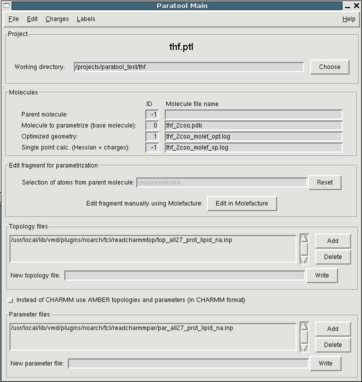Paratool Plugin, Version 1.6

Easy generation of force field parameters
Paratool provides a graphical interface for force field parametrizations of molecules that are not contained in your force field. It is designed to generate CHARMM or AMBER compliant parameters (while it is more specialized on CHARMM).
The plugin helps you to generate the molecule or the moleular fragment that should be parametrized and to set up the necessary quantumchemical calculations (you'll need Gaussian, later versions will also support GAMESS). Paratool reads the logfiles of the QM simulations, computes force field parameters for bonds, angles dihedrals and impropers by transforming the Hessian into internal coordinates and converting all values into units based on kcal/mol, Å and degrees. You can assign atom types and the corresponding VDW parameters from a list of already existing types or generates new types (all chemical elements H - Rn supported). The charges can be determined using restricted electrostatic potential fitting RESP (AMBER style) or CHARMM style charges using their supramolecular approach which requires another Gaussian calculation.
Paratool generates input for all necessary external programs collects and compiles all the necessary data, organizes and displays them neatly in lists and projects them onto your molecule in VMD. Finally it will write the topology and parameter files you'll need to build the molecule using psfgen and run your simulation in your favourite simulation package, e.g. NAMD.
Download
Paratool is part of VMD, which you can download here.
Documentation
Even though Paratool simplifies force field parametrization a lot you'll still need to know what you are doing. We are currently preparing a manuscript that will give a detailed overview over the complete force field parametrization process. Please check back!
Paratool's user guide is a practical guide through the parametrization procedure but also also contains a reasonable amount of background information.
Citation
Manuscript in preparation.
Author:
Jan Saam with contributions from Peter Freddolino and John Eargle.



